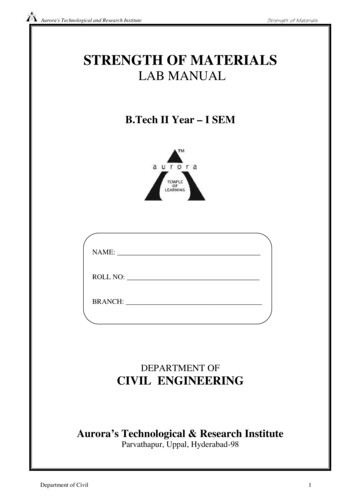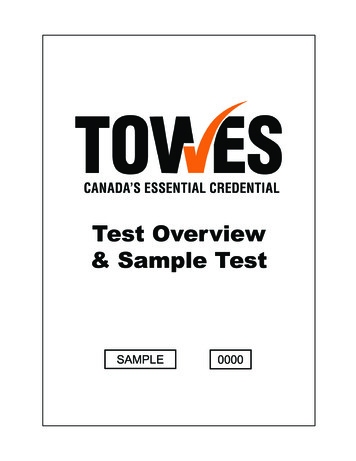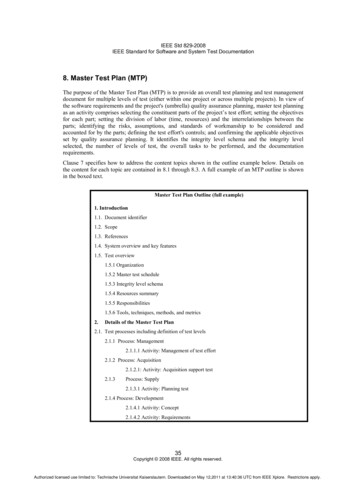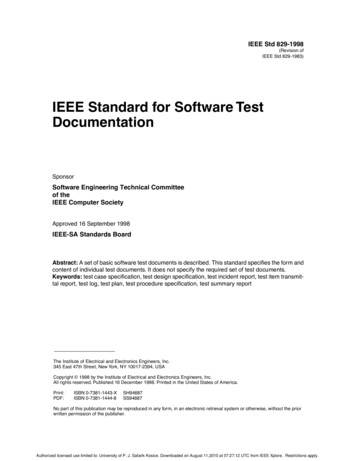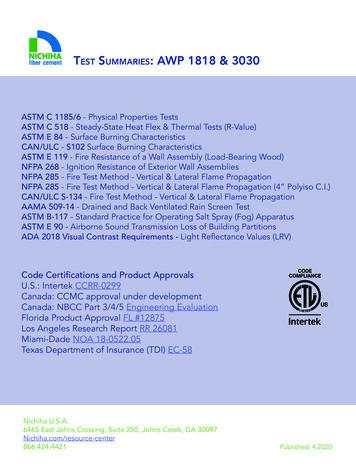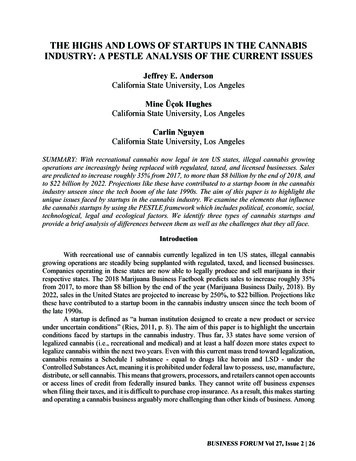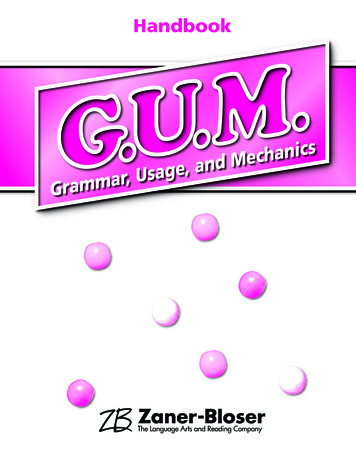
Transcription
HandbookGrama,egasmar, Uscinahcnd Me
Grammar, Usage, and Mechanics HandbookTable of ion . . . . . . . . . . . . . . . . . . . . . . . . . . . . . . . . . . . . . . . . . . . . . . . . . . . . . . .Abbreviations and Initials . . . . . . . . . . . . . . . . . . . . . . . . . . . . . . . . . . . . . . . . . . . . . .Titles . . . . . . . . . . . . . . . . . . . . . . . . . . . . . . . . . . . . . . . . . . . . . . . . . . . . . . . . . . . . . .Quotation Marks . . . . . . . . . . . . . . . . . . . . . . . . . . . . . . . . . . . . . . . . . . . . . . . . . . . .Spelling . . . . . . . . . . . . . . . . . . . . . . . . . . . . . . . . . . . . . . . . . . . . . . . . . . . . . . . . . . . .End Marks . . . . . . . . . . . . . . . . . . . . . . . . . . . . . . . . . . . . . . . . . . . . . . . . . . . . . . . . .Apostrophes . . . . . . . . . . . . . . . . . . . . . . . . . . . . . . . . . . . . . . . . . . . . . . . . . . . . . . . .Commas, Semicolons, and Colons . . . . . . . . . . . . . . . . . . . . . . . . . . . . . . . . . . . . . . .Hyphens, Parentheses, and Dashes . . . . . . . . . . . . . . . . . . . . . . . . . . . . . . . . . . . . . . .305305306306307307307308309Sentence Structure and Parts of ctionSection1011121314151617Section n19202122232425The Sentence . . . . . . . . . . . . . . . . . . . . . . . . . . . . . . . . . . . . . . . . . . . . . . . . . . . . . . . .Subjects . . . . . . . . . . . . . . . . . . . . . . . . . . . . . . . . . . . . . . . . . . . . . . . . . . . . . . . . . . . .Predicates . . . . . . . . . . . . . . . . . . . . . . . . . . . . . . . . . . . . . . . . . . . . . . . . . . . . . . . . . .Simple, Compound, and Complex Sentences . . . . . . . . . . . . . . . . . . . . . . . . . . . . . . .Fragments, Run-ons, Comma Splices, and Ramble-ons . . . . . . . . . . . . . . . . . . . . . . .Nouns . . . . . . . . . . . . . . . . . . . . . . . . . . . . . . . . . . . . . . . . . . . . . . . . . . . . . . . . . . . . .Adjectives . . . . . . . . . . . . . . . . . . . . . . . . . . . . . . . . . . . . . . . . . . . . . . . . . . . . . . . . . .Pronouns . . . . . . . . . . . . . . . . . . . . . . . . . . . . . . . . . . . . . . . . . . . . . . . . . . . . . . . . . .17a Personal Pronouns . . . . . . . . . . . . . . . . . . . . . . . . . . . . . . . . . . . . . . . . . . . . . . .17b Subject and Object Pronouns . . . . . . . . . . . . . . . . . . . . . . . . . . . . . . . . . . . . . .17c Pronoun Antecedents . . . . . . . . . . . . . . . . . . . . . . . . . . . . . . . . . . . . . . . . . . . .17d Possessive Pronouns . . . . . . . . . . . . . . . . . . . . . . . . . . . . . . . . . . . . . . . . . . . . . .17e Compound Personal Pronouns . . . . . . . . . . . . . . . . . . . . . . . . . . . . . . . . . . . . .17f Indefinite Pronouns . . . . . . . . . . . . . . . . . . . . . . . . . . . . . . . . . . . . . . . . . . . . . .17g Relative Pronouns . . . . . . . . . . . . . . . . . . . . . . . . . . . . . . . . . . . . . . . . . . . . . . .17h Interrogative Pronouns . . . . . . . . . . . . . . . . . . . . . . . . . . . . . . . . . . . . . . . . . . .17i Demonstrative Pronouns . . . . . . . . . . . . . . . . . . . . . . . . . . . . . . . . . . . . . . . . . .Verbs . . . . . . . . . . . . . . . . . . . . . . . . . . . . . . . . . . . . . . . . . . . . . . . . . . . . . . . . . . . . . .18a Action and Linking Verbs . . . . . . . . . . . . . . . . . . . . . . . . . . . . . . . . . . . . . . . . .18b Transitive and Intransitive Verbs . . . . . . . . . . . . . . . . . . . . . . . . . . . . . . . . . . . .18c Main Verbs and Auxiliary Verbs . . . . . . . . . . . . . . . . . . . . . . . . . . . . . . . . . . . . .18d The Principal Parts of a Verb . . . . . . . . . . . . . . . . . . . . . . . . . . . . . . . . . . . . . . .18e Verb Tense . . . . . . . . . . . . . . . . . . . . . . . . . . . . . . . . . . . . . . . . . . . . . . . . . . . . .18f Subject and Verb Agreement . . . . . . . . . . . . . . . . . . . . . . . . . . . . . . . . . . . . . . .18g Active and Passive Voice . . . . . . . . . . . . . . . . . . . . . . . . . . . . . . . . . . . . . . . . . .Adverbs . . . . . . . . . . . . . . . . . . . . . . . . . . . . . . . . . . . . . . . . . . . . . . . . . . . . . . . . . . .Prepositions . . . . . . . . . . . . . . . . . . . . . . . . . . . . . . . . . . . . . . . . . . . . . . . . . . . . . . . .Direct Objects and Indirect Objects . . . . . . . . . . . . . . . . . . . . . . . . . . . . . . . . . . . . . .Conjunctions . . . . . . . . . . . . . . . . . . . . . . . . . . . . . . . . . . . . . . . . . . . . . . . . . . . . . . .Interjections . . . . . . . . . . . . . . . . . . . . . . . . . . . . . . . . . . . . . . . . . . . . . . . . . . . . . . . .Appositives . . . . . . . . . . . . . . . . . . . . . . . . . . . . . . . . . . . . . . . . . . . . . . . . . . . . . . . . .Verbals and Absolutes . . . . . . . . . . . . . . . . . . . . . . . . . . . . . . . . . . . . . . . . . . . . . . . . ntinued on page 304)Name
(Continued from page nSectionSection2627282930313233Negatives. . . . . . . . . . . . . . . . . . . . . . . . . . . . . . . . . . . . . . . . . . . . . . . . . . . . . . . . . . .Comparisons . . . . . . . . . . . . . . . . . . . . . . . . . . . . . . . . . . . . . . . . . . . . . . . . . . . . . . . .Contractions . . . . . . . . . . . . . . . . . . . . . . . . . . . . . . . . . . . . . . . . . . . . . . . . . . . . . . . .Plural Nouns . . . . . . . . . . . . . . . . . . . . . . . . . . . . . . . . . . . . . . . . . . . . . . . . . . . . . . . .Possessive Nouns . . . . . . . . . . . . . . . . . . . . . . . . . . . . . . . . . . . . . . . . . . . . . . . . . . . . .Dangling and Misplaced Modifiers . . . . . . . . . . . . . . . . . . . . . . . . . . . . . . . . . . . . . . .Problem Words . . . . . . . . . . . . . . . . . . . . . . . . . . . . . . . . . . . . . . . . . . . . . . . . . . . . . .Homophones . . . . . . . . . . . . . . . . . . . . . . . . . . . . . . . . . . . . . . . . . . . . . . . . . . . . . . .321321322322322322323325Letters and E-mailsSection 34 Letters . . . . . . . . . . . . . . . . . . . . . . . . . . . . . . . . . . . . . . . . . . . . . . . . . . . . . . . . . . . . . 327Section 35 E-mails . . . . . . . . . . . . . . . . . . . . . . . . . . . . . . . . . . . . . . . . . . . . . . . . . . . . . . . . . . . . 328ResearchSection 36 Library Research . . . . . . . . . . . . . . . . . . . . . . . . . . . . . . . . . . . . . . . . . . . . . . . . . . . . . 328Section 37 Internet Research. . . . . . . . . . . . . . . . . . . . . . . . . . . . . . . . . . . . . . . . . . . . . . . . . . . . . 329Section 38 Bibliographies . . . . . . . . . . . . . . . . . . . . . . . . . . . . . . . . . . . . . . . . . . . . . . . . . . . . . . . 329Guidelines for Listening and SpeakingSection 39 Listening . . . . . . . . . . . . . . . . . . . . . . . . . . . . . . . . . . . . . . . . . . . . . . . . . . . . . . . . . . . 330Section 40 Speaking . . . . . . . . . . . . . . . . . . . . . . . . . . . . . . . . . . . . . . . . . . . . . . . . . . . . . . . . . . . 330(you) Diagram sentencesSection 41 Diagraming Sentences . . . . . . . . . . . . . . . . . . . . . . . . . . . . . . . . . . . . . . . . . . . . . . . . . 330
MechanicsSection 1 Capitalization Capitalize the first word in a sentence.The kangaroo rat is an amazing animal. Capitalize all proper nouns, including people’s names and the names of particular places.Gregory GordonWWashingtonMonument Capitalize titles of respect.Mr. AlvarezDr. ChinMs. Murphy Capitalize family titles used just before people’s names and titles of respect that are part of names.Uncle FrankAunt MaryGovernor Adamson Capitalize initials of names.Thomas Paul Gerard (T.P. Gerard) Capitalize place names.FranceUtahChinaBaltimore Capitalize proper adjectives, adjectives that are made from proper nouns.ChineseIcelandicFrenchLatin American Capitalize the months of the year and the days of the week.FebruaryAprilMondayTuesday Capitalize important words in the names of organizations.American Lung AssociationVVeteransof Foreign WarsW Capitalize important words in the names of holidays.VVeteransDayFourth of July Capitalize the first word in the greeting or closing of a letter.Dear Edmundo,YYourstruly, Capitalize the word I.IFrances and I watched the movie together. Capitalize the first, last, and most important words in a title. Be sure to capitalize all verbs,including is and was.IIsland of the Blue DolphinsolphinsAway IIs a StrangeSPlace to BeP Capitalize the first word in a direct quotation.Aunt Rose said, “Please pass the clam dip.”Section 2 Abbreviations and InitialsAbbreviations are shortened forms of words. Many abbreviations begin with a capital letter and endwith a period.can abbreviate words used in addresses when you write.Street (St.) Avenue (Ave.()Route (Rte.)Boulevard (Blvd.)Road (Rd.) Drive (Dr.) You can abbreviate the names of states when you address envelopes.Note: State names are abbreviated as two capital letters, with no periods.Alabama (AL)Idaho (ID)Missouri (MO)Pennsylvania (PA)Alaska (AK)Illinois (IL)Montana (MT)Rhode Island (RI)Arizona (AZ)Indiana (IN)Nebraska (NE)South Carolina (SC)Arkansas (AR)Iowa (IA)Nevada (NV)South Dakota (SD)California (CA)Kansas (KS)New Hampshire (NH)Tennessee (TN)Colorado (CO)Kentucky (KY)New Jersey (NJ)Texas (TX)Connecticut (CT)Louisiana (LA)New Mexico (NM)Utah (UT)Delaware (DE)Maine (ME)New York (NY)Vermont (VT)District ofMaryland (MD)North Carolina (NC)Virginia (VA)Columbia (DC)Massachusetts (MA)North Dakota (ND)Washington (WA)Florida (FL)Michigan (MI)Ohio (OH)West Virginia (WV)Georgia (GA)Minnesota (MN)Oklahoma (OK)Wisconsin (WI)Hawaii (HI)Mississippi (MS)Oregon (OR)Wyoming (WY)
You can abbreviate titles of address and titles of respect when you write.Mister (Mr. Brian Davis) Mistress (Miss or Mrs. Maria Rosario) General (Gen. Robert E. Lee)Doctor (Dr. Emily Chu) Junior (Everett Castle, Jr.)Saint (St. Andrew)Note: Ms. is a title of address used for women. It is not an abbreviation, but it requires a period(Ms. Anita Brown). You can abbreviate certain words in the names of businesses when you write.Pet Helpers, Incorporated (Pet Helpers, Inc.)Zykar Corporation (Zykar Corp.Corp.) You can abbreviate days of the week when you take notes.Sunday (Sun.)Wednesday (Wed.()Friday (Fri.)Monday (Mon.)Thursday (Thurs.)Saturday (Sat.)Tuesday (Tues.) You can abbreviate months of the year when you take notes.January (Jan.()April (Apr.()October (Oct.)February (Feb.)August (Aug.()November (Nov.)March (Mar.)September (Sept.)December (Dec.)(May, June, and July do not have abbreviated forms.) You can abbreviate directions when you take notes.North (N)East (E)South (S)West (W( W)An initial is the first letter of a name. An initial is written as a capital letter and a period. Sometimesinitials are used in the names of countries or other places.Michael Paul Sanders (M.P. Sanders)United States of America (U.S.A.)Washington, District of Columbia (Washington, D.C.)An acronym is a special type of abbreviation that is formed from the first letters of a group of words.Some acronyms, such as NASA (National Aeronautics and Space Administration), are written in allcapitals. Others, such as scuba (self-contained underwater breathing apparatus), are written as regular,lowercased words.Section 3 Titles Underline titles of books, newspapers, TV series, movies, and magazines.Island of the Blue DolphinsMiami HeraldI Love LucyNote: These titles are written in italics in printed text. Use quotation marks around articles in magazines, short stories, chapters in books, songs, and poems.“This Land Is Your Land”“The Gift”“Eletelephony” Capitalize the first, last, and most important words in titles. Articles, short prepositions, andconjunctions are usually not capitalized. Be sure to capitalize all verbs, including forms of theverb be (am, is, are, was, were, been).A Knight in the AtticMy Brother Sam Is DeadSection 4 Quotation Marks Put quotation marks (“ ”) around the titles of articles, short stories, book chapters, songs, andpoems.My favorite short story is “Revenge of the Reptiles.” Put quotation marks around a direct quotation, or a speaker’s exact words.“Did you see that alligator?” Max asked. Do not put quotation marks around an indirect quotation, a person’s words retold by anotherspeaker. An indirect quotation is often signalled by whether or that.thatMax asked Rory whether he had seen an alligator.
Writing a Conversation Put quotation marks around the speaker’s words. Begin a direct quotation with a capital letter.Use a comma to separate the quotation from the rest of the sentence.Rory said, “There are no alligators in this area.” When a direct quotation comes at the end of a sentence, put the end mark inside the lastquotation mark.Max cried, “Look out!” When writing a conversation, begin a new paragraph with each change of speaker.Max panted, “I swear I saw a huge, scaly tail and a flat snout in the water!”“Relax,” Rory said. “I told you there are no alligators around here.”Section 5 SpellingUse these tips if you are not sure how to spell a word you want to write:the word aloud and break it into syllables. Try spelling each syllable. Put the syllablestogether to spell the whole word. Write the word. Make sure there is a vowel in every syllable. If the word looks wrong to you,try spelling it other ways. Think of a related word. Parts of related words are often spelled the same.Decide is related to decision.Correct spelling helps readers understand what you write. Use a dictionary when you need help.When you use the word processing function of a computer to write something, you can use the spellcheck feature. It will identify possible spelling errors in your writing. A spell checker will not catch errorswith homophones, though. For example, if you type break instead of brake, the spell checker will notcatch the mistake, because the word is spelled correctly.correctlySection 6 End MarksEvery sentence must end with a period, an exclamation point, or a question mark. Use a period at the end of a statement (declarative sentence) or a command (imperative sentence).Dad and I look alike. (declarative)declarativeStep back very slowlyslowly. (imperative)imperative Use an exclamation point at the end of a firm command (imperative sentence) or at the end ofa sentence that shows great feeling or excitement (exclamatory sentence).Get away from the cliff ! (imperative)imperativeWhat an incredible sight! (exclamatory)exclamatory Use a question mark at the end of an asking sentence (interrogative sentence).How many miles is it to Tucson? (interrogative)interrogativeSection 7 ApostrophesAn apostrophe (’) is used to form the possessive of a noun or to join words in a contraction. Possessives show ownership. To make a singular noun possessive, add ’ s.The bike belongs to Carmen. It is Carmen’s bike. To form a possessive from a plural noun that ends in s, add only an apostrophe.Those books belong to my sisters. They are my sisters’ books. Some plural nouns do not end in s. To form possessives with these nouns, add ’ s.The children left their boots here. The children’s boots are wet. Use an apostrophe to replace the dropped letters in a contraction. it’s (it is) hasn’t (has not)
Section 8 Commas, Semicolons, and ColonsCommas in Sentences Use a comma after an introductory word in a sentence.Yes, I’d love to go to the movies.Actually, we had a great time.Actually Use a comma to separate items in a series. A series is a list of three or more items. Put the lastcomma before and or or. A comma is not needed to separate two items.Shall we eat cheese, bread, or fruit?Let’s eat cheese and fruit. Use a comma to separate a noun of direct address from the rest of a sentence.Akila, will you please stand up?We would like you to singsing, Akila. Use a comma to separate a direct quotation from the rest of a sentence.Joe asked, “How long must I sit here?”“You must sit there for one hour,” Vic said. Use a comma with the conjunction and, or, or but when combining independent clauses in acompound sentence.Lisa liked the reptiles best, but Lyle preferred the amphibians. Use a comma to separate a dependent clause at the beginning of a sentence from the rest ofthe sentence.Because Lisa likes reptiles, she is considering a career as a herpetologist. Use a comma to separate a pair of adjectives that are of a similar kind. To decide whether toput a comma between adjectives, try reading the sentence with the word and inserted betweenthe adjectives. If the word and sounds natural there, you should use a comma.Reptiles have drydry, scaly skin. (needs a comma)Look at that big green lizard! (does not need a comma) Use commas to set off a nonrestrictive adjective clause. A nonrestrictive clause is one that addsinformation about the word it modifies but is not essential to the meaning of the sentence.Walt Jackson, who sold me a turtle last year, has a new pet gecko. (The adjective clause just tellsmore about the noun it modifies. Because the information in the clause is not essential, the clauseis nonrestrictive. Commas are needed.)The woman who runs the pet store offered me a job. (The adjective clause tells which woman isbeing talked about. Because the information in the clause is essential, no commas are used.)Semicolons and Colons in Sentences You may use a semicolon in place of a comma and a conjunction when combining independentclauses.Lisa likes reptiles; Lyle prefers amphibians. A colon can be used when the second clause states a direct result of the first or explains the first.Lisa owns reptiles: she has two pet snakes. Use a colon to introduce a list or series.I like three kinds of cheese: cheddar, Swiss, and colby.colby Use a colon to introduce a quotation.Cory always follows this motto: “A penny saved is a penny earned.” Use a colon after the speaker’s name in a play.LOGAN: Where were you on the night of October 5th, when the gold bullion was stolen?BLAKE: I was attending the opening night of Carmen at the opera house. Use a colon to separate hours and minutes in an expression of time.8:15 P.PM.11:45 A.M. Use a colon between the city of publication and the publisher in a bibliographic entry.O’Dell, Scott. The Cruise of the Arctic Star. Boston: Houghton Mifflin, 1973.Commas with Dates and Place Names Use a comma to separate the day from the date and the date from the year.We clinched the division championship on SaturdaySaturday, September 20, 2008. Use a comma to separate the name of a city or town from the name of a state.I visited Memphis, Tennessee.
Commas and Colons in Letters Use a comma after the greeting and the closing of a friendly letter.Dear Reginald,Your friend, Deke Use a colon after the greeting of a business letter. Use a comma after the closing.Dear Ms. Brocklehurst:Sincerely,SincerelySection 9 Hyphens, Parentheses, and DashesHyphens in Sentences When you break a word at the end of a line, use a hyphen to separate the syllables.There is no single “perfect food.” Milk, for example, contains most of the nutrients needed by the human body, but it lacks enough iron. Use hyphens to link the parts of some compound words.son-in-lawcity-state Use hyphens to link some pairs or groups of words that precede a noun and act as an adjective.a family-style meala horse-drawn carriagean up-to-date schedule Use hyphens to link the parts of numbers between twenty-one and nty-sixseventythirty-fivethirtyParentheses in Sentences Use parentheses to set off an explanation.I interviewed my uncle (he raises goats for a living) for my report on animal husbandry.husbandryRolf and Dana’s farm is 100 miles (160 km) outside of Chicago. Use parentheses to set off an example.Many types of cheese (chèvre, for example) are made with goats’ milk.Dashes in Sentences Use a dash to signal a pause. A dash is longer than a hyphen. Use a dash to mark an interrupted or unfinished sentence.“There is nothing to worry about,” said Tim. “I’m sure that—” Use dashes to set off a phrase or an independent clause that interrupts an otherwise completesentence.I stayed in the shade—my skin burns easily—and enjoyed the band’s music. Use a dash to stress one or more words at the end of a sentence.There is one plant a hiker absolutely must learn to recognize—poison oak.
Sentence Structure and Parts of SpeechSection 10 The SentenceA sentence is a group of words that tells a complete thought. A sentence has two parts:a subject and a predicate. The subject tells whom or what the sentence is about.The swimmers race. The predicate tells what the subject is or does.The judges watch carefullycarefully.There are four kinds of sentences: declarative, interrogative, imperative, and exclamatory. A declarative sentence makes a statement and ends with a period.Jake swam faster than anyone. An interrogative sentence asks a question and ends with a question mark.Did Sammy qualify for the finals? An imperative sentence gives a command and usually ends with a period; a firm command canend with an exclamation point.Keep your eyes on the finish line.Watch out for that bee! An exclamatory sentence ends with an exclamation point.Jake has won the race!Section 11 SubjectsThe subject of a sentence tells whom or what the sentence is about. A sentence can have one subject.Mary wrote a book. A sentence can have a compound subject, two or more subjects that are joined by a conjunction(and,and, oror) and that share the same predicate.Alex and Mark have already read the book. Imperative sentences have an unnamed understood subject, the person being spoken to. Thissubject is referred to as “understood you.”Give me the book, please.The complete subject includes all the words that name and tell about the subject.Many students have borrowed the book.The simple subject is the most important noun or pronoun in the complete subject.Many students have borrowed the book.They discussed the book yesterday.yesterdayNote: Sometimes the simple subject and the complete subject are the same. Ricardo is writing a book.Section 12 PredicatesThe predicate of a sentence tells what happened. The complete predicate includes a verb and all the wordsthat tell what happened or tell more about the subject. A complete predicate can include an action verb to tell what the subject of the sentence did.Mary won an award. A complete predicate can include a linking verb to tell more about the subject.Mary is a talented writer.writerThe simple predicate is the verb that goes with the subject. It generally tells what the subject did, does, orwill do.Celia won an award for her performance.She will receive a trophy next week.A compound predicate is two or more predicates that share the same subject. Compound predicates areoften joined by the conjunction and or or.Ramon sang and danced in the play.playMary wrote the play and directed it.A predicate noun follows a linking verb and renames the subject.Mary is a writer.Ramon is a singersinger.A predicate adjective follows a linking verb and describes the subject.Mary is talented.Ramon is clever.
Section 13 Simple, Compound, and Complex SentencesA simple sentence tells one complete thought.Arthur has a rock collection.A compound sentence is made up of two simple sentences (or independent clauses) whose ideas arerelated. The clauses can be joined by a comma and a conjunction (and, or, but).Arthur has a rock collection, and Mary collects shells.The two independent clauses in a compound sentence can also be joined by a semicolon.Arthur collects rocks; Mary collects shells.Two clauses in a compound sentence can be separated by a colon when the second clause is a direct resultof the first clause.Arthur enjoys visiting new places: he can hunt for rocks to add to his collection.A complex sentence is made up of one independent clause and at least one dependent clause. A dependentclause is a group of words that has a subject and a predicate, but it cannot stand on its own.Dependent Clause:when Arthur visited ArizonaIndependent Clause: He learned a lot about desert plants.Complex Sentence:When Arthur visited Arizona, he learned a lot about desert plants.A compound-complex sentence includes two or more independent clauses and at least one dependent clause.Independent Clauses:Arizona is proud of its saguaro cactus.The saguaro cactus can grow up to sixty feet tall.Dependent Clause:which is also called the giant cactusCompound-complex Sentence: Arizona is proud of its saguaro cactus; the saguaro, which isalso called the giant cactus, can grow up to sixty feet tall.An adjective clause is a dependent clause that describes a noun or pronoun. An adjective clause alwaysfollows the word it describes and begins with a relative pronoun such as who, whom, whose, which, or that.My cousin Arthur, who has a rock collection, visited the Arizona desert. (describes Arthur)He studied the interesting rock formations that rise above the desert floor. (describes formations)An adverb clause is a dependent clause that tells more about a verb, an adjective, or an adverb. Adverbclauses tell where, when, why, or how much. They often begin with a subordinating conjunction suchas after, since, where, than, although, because, if, as, as if, while, when, or whenever.Whenever Arthur came across an unfamiliar rock, he took a photograph of it.(tells when Arthur took a photograph)Arthur didn’t take any rocks away because the desert environment is fragilefragile.(tells why Arthur didn’tdid take rocks away)A noun clause is a dependent clause that functions as the subject of a sentence or the object of a verb.A noun clause begins with a relative pronoun.She said that the floor was slipperyslippery. (The noun clause that the floor was slippery is the direct object ofthe verb said.)Most simple sentences and independent clauses follow what is called the natural order of sentenceelements: first the subject; then the verb; then the direct object, predicate noun, or predicate adjective.S VDOS VDOI will take the turkey with me; I will leave the yams behind.S LV PAThe leaves are green.In some simple sentences and independent clauses, a verb, direct object, predicate noun, or predicateadjective comes before the subject. A sentence with this order of elements is said to have inverted order.DO S VDO S VThe turkey I will take with me; the yams I will leave behind.PA LVSGreen are the leaves.
A sentence in which a dependent clause appears between the subject and the verb is said to haveinterrupted order.SDCLVThanksgiving, which came early this year, is my favorite holiday.holidaySection 14 Fragments, Run-ons, Comma Splices, and Ramble-onsA fragment is an incomplete sentence that does not tell a complete thought.Sumi and Ali. (missing a predicate that tells what happened )Went hiking in the woods. (missingmissing a subject that tells who went hikinghiking)A run-on sentence is two complete sentences that are run together. To fix a run-on sentence, use acomma and a conjunction (and, or, but) to join the two sentences. (You may also join the sentenceswith a semicolon.)Incorrect: Sumi went hiking Ali went swimming.Correct: Sumi went hikinghiking, but Ali went swimming.A comma splice is two complete sentences that have a comma between them but are missing aconjunction (and, or, but). To fix a comma splice, add and, or, or but after the comma.Incorrect: Sumi went hiking yesterday, Ali went swimming.Correct: Sumi went hiking yesterday, and Ali went swimming.A ramble-on sentence is grammatically correct but contains extra words that don’t add to its meaning.Incorrect: Hiking through the wilderness to enjoy nature is my favorite outdoor sports activity,probably because it is so enjoyable and such good exercise, and because I enjoyobserving wild animals in the wilderness in their natural environment.Correct: Hiking through the wilderness to enjoy nature is my favorite outdoor sports activity.activityI enjoy observing wild animals in their natural environment.Try not to string too many short sentences together when you write. Instead, combine sentences andtake out unnecessary information.Incorrect: I stared at him and he stared at me and I told him to go away and he wouldn’t sothen I called my big sister.Correct: We stared at each other.other I told him to go away, but he wouldn’t. Then I called my big sister.sisterSection 15 NounsA common noun names any person, place, thing, or idea.Ira visited an auto museum with his friends. Ira has always had an interest in cars.He likes that blue convertible.A proper noun names a certain person, place, thing, or idea. Proper nouns begin with a capital letter.A proper noun that is made up of two or more words is considered one noun.Ira wants to visit the Sonoran Desert in Mexico in April 2009.He is reading a guidebook about the region entitled The Undiscovered DesertDesert.A collective noun names a group of people or things that act as one unit.juryfamilycommitteeaudiencecrowd Most often, a collective noun is treated as a singular subject.The track team is the strongest one we’ve had in years. Sometimes, if a writer wants to emphasize the different members of a group, he or she maytreat the noun as a plural subject.The track team are congratulating one another on their fine performances. A noun can also be used to describe another noun.freeway exiteye chartocean current
Section 16 AdjectivesAn adjective is a word that tells more about a noun or a pronoun. Some adjectives tell what kind.Jim observed the huge elephant. The enormous beast tower
Grammar, Usage, and Mechanics Handbook Table of Contents Mechanics . Mechanics Section 1 Capitalization Capitalize the first word in a sentence. The kangaroo rat is an amazing animal. Capitalize all propernouns, inc


